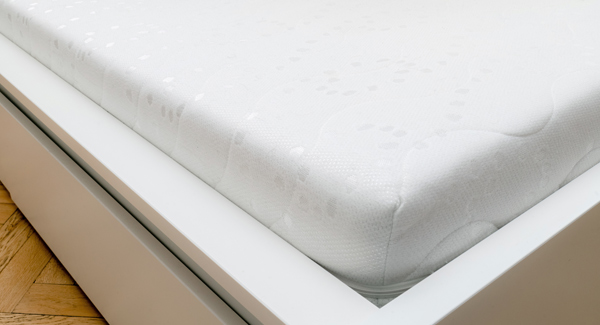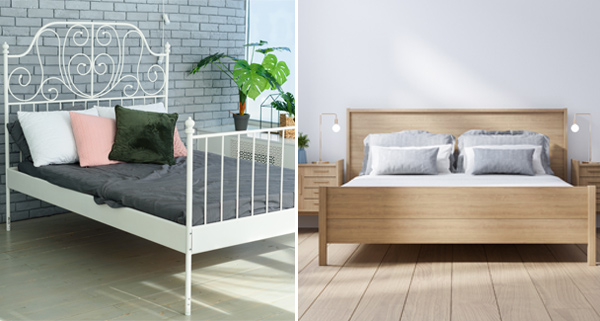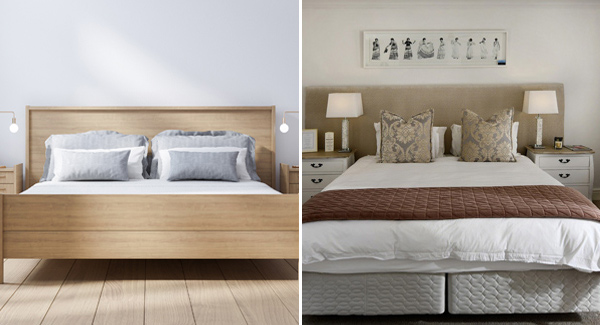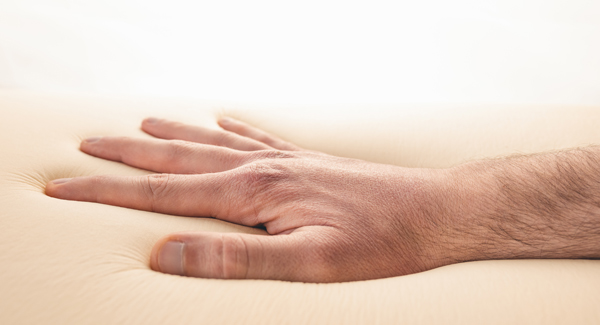Home » Mattress types » What Type Of Bed Base Is Suitable For A Memory Foam Mattress?
What type of bed base is suitable for a memory foam mattress?
Article navigation
- Published:
- Written by: Tony Brown
- Topic: Mattress types
Memory foam is a popular mattress material that gently moulds and adapts to the body, providing crucial support and pressure relief. If you have or intend to purchase a memory foam mattress, pairing it with a suitable bed base is essential, as this can affect how the mattress feels and performs.
Always place a memory foam mattress on a well-ventilated bed base that allows good air circulation to prevent moisture build-up. The mattress should also rest on an even surface.
Memory foam mattresses tend to perform better on slats or solid bases. Slats are ideal because there is often plenty of air circulation underneath. However, the spacing between the slats should not exceed the manufacturer’s recommendations. Otherwise, the mattress may sag between the gaps, affecting support and potentially damaging the mattress. Slat spacing recommendations will vary for each manufacturer, but the slats should generally be no more than 90 mm apart. If the slats are wider, place a sheet of plywood board on top of the slats to create an even surface. Then, drill holes in the plywood for ventilation.
It’s also advisable to place a breathable blanket or a mattress pad directly on top of the slats to protect the mattress from splinters and damage.
Slatted bed bases can have solid or sprung slats to support the mattress. Solid slats are rigid wooden planks spanning the frame’s width. In contrast, sprung slats, typically made from laminated woods like beech, are curved and more flexible, providing a subtle springiness and a softer feel compared to solid slats.
Avoid placing a memory foam mattress on a cheap or worn-out bed base. The base is unlikely to provide adequate support, and if the base is uneven, the mattress will simply conform to its shape. Furthermore, placing a mattress on an unsuitable bed base could invalidate its guarantee or warranty.
Types of bed bases for memory foam mattresses
Most mattresses are paired with different types of bed bases like divans, bed frames, or adjustable beds. Remember to ensure the mattress and the bed base are suitable for use together, especially if you’re buying them separately.
Bed frames
Bed frames, also known as bedsteads, are available in many beautiful designs and materials. Most bed frames come with slats to support the mattress, but some frames may have a metal grid or even a bedstead divan that sits inside the frame for support.
While many select a bed frame based on its visual appeal, they often overlook other factors like bed height. Many bed frames are low to the floor, making it challenging for some individuals, like older adults or those with mobility issues, to get in and out of bed comfortably. Additionally, memory foam mattresses tend to be quite deep. They can obscure much of the headboard and make it uncomfortable to lean against.
Bed frames typically take up more room space than other bed bases because the mattress often sits inside the frame. So, measuring up before ordering is advisable to ensure the frame fits into the bedroom and there is enough space to walk around the bed when the frame is assembled. You may also notice a gap between the mattress and the frame.
Divans
A divan base is a wooden box frame typically covered in material. There are typically two types of divan base – sprung edge and platform top. Sprung edge divans have a layer of springs mounted to the top of the frame for cushioning. In contrast, platform tops are constructed without springs and are usually made from hardboard.
While a sprung base may seem more luxurious, not all memory foam mattresses are compatible with this type of base. Memory foam is a temperature-sensitive material, which gradually becomes softer overnight.
Though some people prefer a mattress that cradles and conforms to body shape, others might feel they sink too far into the mattress, making it harder to change sleeping positions. When paired with a sprung base, memory foam becomes even softer, exacerbating the sinking sensation for some sleepers.
Poor edge support can also be an issue with memory foam mattresses. Without reinforced edges, memory foam can sag, sometimes making sleepers feel like they are falling out of bed. Placing a memory foam mattress on a sprung base may exacerbate the issue. Therefore, memory foam tends to perform better on slats on solid bed bases.
However, certain hybrid models, which combine springs and foam may be suitable for use with a sprung base. These mattresses feel slightly bouncier, making it easier to turn over and mitigating the sinking concerns sometimes associated with all-foam mattresses.
Ottoman beds
Ottoman beds are ideal for those requiring additional bedroom storage. These beds feature a base that lifts either from the end or the side, revealing a large hidden compartment for storage.
Ottoman beds come in various attractive designs and materials, as both divans and bed frames. Manufacturers typically specify a maximum mattress weight limit for their ottoman beds. So it’s important to check the memory foam mattress and base are suitable for use together.
Adjustable bed bases
Most sprung mattresses are not designed to be bent or folded and are, therefore, unsuitable for use on an adjustable bed base. However, memory foam mattresses are more flexible and can usually conform to the shape of the adjustable base without getting damaged when in operation.
However, most adjustable bed bases require a mattress that is 200 cm long. Standard single and double mattresses are typically only 190 cm long.
Therefore, if you’re considering an adjustable base, you need to pair it with a compatible mattress of the same length. This will prevent the mattress from sliding when the bed is in operation.
Do memory foam mattresses slide?
Memory foam mattresses are single-sided and only have one sleeping surface. However, some may lack traction on the underside, causing them to slide or shift on the bed base. Consider a bed base with an anti-slip surface to prevent the mattress from sliding.
Can you place a memory foam mattress directly on the floor?
Though some manufacturers allow you to place a memory foam mattress on the floor, this should generally be avoided. The lack of airflow underneath the mattress can lead to mould and mildew growth. Sleeping closer to the floor exposes you to cold air, dust, and pests.
Final thoughts
Selecting the right bed base for your memory foam mattress is just as crucial as choosing the mattress itself. Take your time and choose wisely. Before ordering, measure your property to ensure the base fits into your intended room. This includes measuring doorways, hallways, staircases, tight bends, and ceiling heights.
Share this article

About the author
Tony Brown is the founder and creator of The Bed Consultant. His career in the bed industry began in 2002. After graduating from university with a degree in Business Administration, Tony joined one of the largest independent furniture retailers in the UK as a bed consultant. Tony has helped thousands of customers find the perfect mattress.





